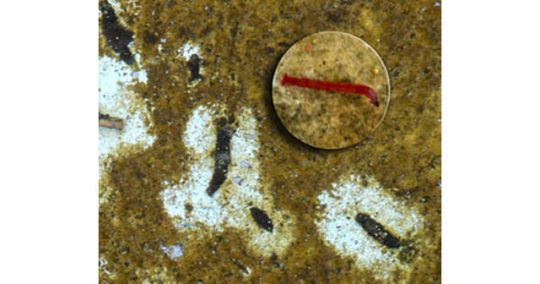#Scolecida
Explore tagged Tumblr posts
Text
Taxonomy Tournament: Annelids


Terebellida. Marine worms of this order are sessile detritivores that live within a tube they form out of sand. It includes extremophiles like the Pompeii worms
Scolecida. This infraclass of marine worms feed on detritus, and includes bamboo worms and lugworms
#animals#biology#polls#poll tournament#zoology#pompeii worms#worms#annelids#spiralia#lugworms#Terebellida#Scolecida#0x41v0xbe#animal tournament#Animal Tournament Round 1
32 notes
·
View notes
Text

Mollusca and scolecida engraving - 1882.
1 note
·
View note
Photo

Bristle worm (Scoloplos armiger)
Photo by Marlin Harms
#bristle worm#scoloplos armiger#scoloplos#orbiniinae#orbiniidae#scolecida#sedentaria#polychaeta#annelida#lophotrochozoa
146 notes
·
View notes
Photo

Blood worm
Blood worm or bloodworm is an ambiguous term and can refer to: The larvae of a non-biting midge (Family Chironomidae) containing hemoglobin The polychaete Glycera, often used for fishing bait Species of the Polychaeta subclass Scolecida. Lumbriculus variegatus, more commonly called blackworm, but often misnamed by pet stores Strongylus vulgaris, a common horse parasite Angiostrongylus cantonensis, a parasitic nematode that causes of Angiostrongyliasis and the most common cause of eosinophilic meningitis More details Android, Windows
2 notes
·
View notes
Photo

Capitella capitata
...is a species of Capitellid polychaete worm which occurs in shore to sub-littoral zones worldwide. Capitella capitata will occupy a range of substrates ranging from muddy/gritty sand, areas under stones, and sediment. C. capitata is an opportunistic species and is very tolerant of a range of stressful conditions, to the point where it has been observed in polluted waters.
Classification
Animalia-Annelida-Polychaeta-Scolecida-Capitellidae-Capitella-C. capitata
Image: Hans Hillewaert
41 notes
·
View notes
Text
Taxonomy Tournament: Results of Round 1
Long post, many stats.
The three biggest landslides were Opiliones (daddy longlegs) beating Parasitiformes (ticks) (87.89%, 334 to 46 votes), Terebellida (Pompeii worms) beating Scolecida (bamboo worms) (88.94%, 193 to 24 votes), and Hemiptera (true bugs) beating Phthiraptera (lice) (91.04%, 19 to 193 votes).
The three closest matches were Perissodactyla (horses and rhinos) beating Pholidota (pangolins) (50.6%, 747 to 765 votes), Caniformia (canines, bears, foxes...) beating Feliformia (felines, mongooses...) (50.28%, 538 to 532 votes), and Struthioniformes (ostriches) and Rheiformes (rheas) tying (50%, 144 to 144 votes).
To break the tie, I will discount my own vote (for Struthioniformes), so Rheiformes win.
Interesting that the top 3 landslides were all invertebrates (actually all top 7), while the 3 closest matches were all between Chordates (actually 4).
The average winning percent was 67.10% for all matches, and was 71.28% between non-chordates and 62.91% between chordates. So the chordate matches were closer in general.
As you may have guessed from the biggest landslides, parasites fared quite poorly. While the bracket started with 9 primarily parasitic clades, only 3 made it to this round (Hirudinea [leeches], Eucestoda [tapeworms], D. medinensis [nematode]) and all three were against other parasites.
The biggest landslide among Mammals was Didelphidae (possums) beating Hyracoidea (dassies) (80.26%)
The biggest landslide among Birds was Columbiformes (pigeons and doves) beating (flamingos) (72.34%)
The biggest landslide among Non-Avian Reptiles was Serpentes (snakes) beating Rhynchocephalia (tuatara) (60.60%). The closest match among Reptiles was Iguania (iguanas, chameleons...) beating Anguimorpha (Komodo dragon) (51.09%)
The biggest landslide among Cartilaginous Fish was Myliobatiformes (stingrays) beating Rajiformes (skates) (81.20%). The closest match was Rhinopristiformes (shovelnose ray, sawfish...) beating Torpediniformes (electric rays) (51.44%)
The biggest landslide among Bony Fish (and Chordates in general) was Osteoglossiformes (African Knifefish) beating Hiodontiformes (mooneyes) (84.71%). The closest match was Toxotidae (archerfish) beating Istiophoriformes (swordfish) (50.64%).
The biggest landslide among Echinoderms was Asteroids (starfish) beating Peripodida (sea daisies) (82.95%). The closest match was Echinacea (sea urchins) beating Gnathostomata (sand dollars) (55.38%).
The closest match among Annelids was Eunicida (eg. Bobbit worm) beating Phyllodocida (eg. Gossamer worm) (54.38%)
The biggest landslide among Gastropods was Neomphalida (volcano snails) beating Umbraculoidea (false limpets) (86.67%). The closest was Conidae (cone snails) beating Strombidae (conches) (51.39%)
The biggest landslide among Cephalopods was Sepiida (cuttlefish) beating Spirulida (Ram's horn squid) (77.53%). The closest match was Oegopsida (glass squid, giant squid...) beating Myopsida (European squid, reef squid...) (61.9%).
The biggest landslide among other molluscs was Polyplacophora (chitons) beating Scaphopoda (Tusk Shells) (84.35%). The closest was Heterodonta (edible clams) beating Palaeoheterodonta (freshwater mussels) (52.08%)
The closest match among Insects was Mantodea (mantises) beating Blattodea (roaches and termites) (72.9%). Interestingly still a pretty big landslide.
The biggest landslide among Crustaceans was Thecostraca (barnacles) beating Tantulocarida (parasites of crustaceans) (83.33%). The closest match was Branchiopoda (fairy shrimp) beating Copepods (56.54%)
The closest match among Invertibrates was Eucestoda (tapeworms) beating Amphilinidea (parasites of turtles) (50.65%).
Round 2 starts tomorrow!
#Animal Tournament#Animal Tournament Announcements#biology#taxonomy#animal biology#marine biology#evolution#zoology#tumblr polls#tournament poll#poll tournament#bracket tournament
41 notes
·
View notes